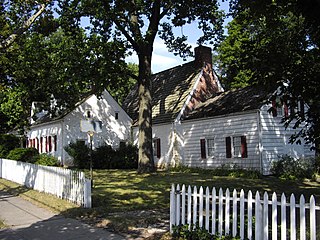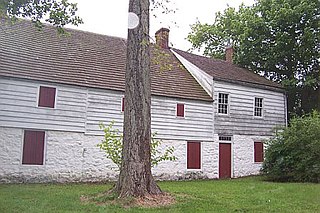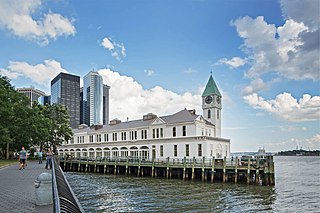
St. George is a neighborhood on the northeastern tip of Staten Island in New York City, along the waterfront where the Kill Van Kull enters Upper New York Bay. It is the most densely developed neighborhood on Staten Island, and the location of the administrative center for the borough and for the coterminous Richmond County. The St. George Terminal, serving the Staten Island Ferry and the Staten Island Railway, is also located here. St. George is bordered on the south by the neighborhood of Tompkinsville and on the west by the neighborhood of New Brighton.
Prince's Bay is the name of a neighborhood located on the South Shore of New York City's borough of Staten Island. Prince's Bay is bordered to the north by Huguenot, to the south by the Raritan Bay, and to the west by Pleasant Plains. The neighborhood is represented in the New York State Senate by Andrew Lanza, in the New York State Assembly by Michael Reilly, and in the New York City Council by Joe Borelli.

Lemon Creek is a stream located on the South Shore of Staten Island in New York City. It is one of the few remaining ground-level creeks in New York City.

Annadale is a middle-class neighborhood on the South Shore of the borough of Staten Island in New York City.

Whitehall Street is a street in the South Ferry/Financial District neighborhood of Lower Manhattan in New York City, near the southern tip of Manhattan Island. The street begins at Bowling Green to the north, where it is a continuation of the southern end of Broadway. Whitehall Street stretches four blocks to the southern end of FDR Drive, adjacent to the Staten Island Ferry's Whitehall Terminal, on landfill beyond the site of Peter Stuyvesant's 17th-century house.

The Billiou–Stillwell–Perine House is a Dutch Colonial structure and the oldest standing building on Staten Island, New York.

The Wyckoff House, or Pieter Claesen Wyckoff House, is a historic house at 5816 Clarendon Road in the Canarsie neighborhood of Brooklyn in New York City. The house is within Milton Fidler Park.

The Seguine Mansion, also known as the Seguine-Burke Mansion, is located on Lemon Creek near the southern shore of Staten Island, New York City. The Greek Revival house is one of the few surviving examples of 19th-century life on Staten Island. It is listed on the National Register of Historic Places and is a member of the Historic House Trust.

The Christopher House is a stone masonry farmhouse at Historic Richmond Town in Staten Island, New York City. It is associated with two of the oldest Staten Island families. It was also used as a meeting place during the American Revolution, while being the residence of Joseph Christopher, a member of the Richmond County Committee of Safety from 1775-1776. It was moved to Historic Richmond Town in late 1969 and restored for museum presentation from 1975-1977.

The Olmsted–Beil House was a large farm and modest Dutch farmhouse at 4515 Hylan Boulevard in the South Shore of Staten Island, New York City. The house was purchased by Frederick Law Olmsted's father and given to Olmsted in 1848 to grow crops, plant trees and clear for pasture for livestock. It is on one of the higher hills overlooking Raritan Bay, and Sandy Hook in New Jersey.

The Britton Cottage, formerly known as the Cubberly House, is a house in the Historic Richmond Town museum complex in the neighborhood of Richmondtown, Staten Island, in New York City. The oldest section of the cottage dates to 1671, with additions in the mid-18th century. It is constructed of stone and timberframe components. The house was originally located at the intersection of New Dorp Lane and Cedar Grove Avenue in the New Dorp Beach section of Staten Island, but was moved to its current location in 1967 when it was threatened with demolition.

The Stephens-Black House is a 19th-century house featured in Historic Richmond Town on Staten Island, New York City. It was designated as a New York City Landmark on August 26, 1969.

The Treasure House is a historic building located in the Richmondtown neighborhood of Staten Island in New York City, New York, U.S. Samuel Grasset, a tanner and leather worker, built the original construction in approximately 1700. Additions were made in 1740, 1790 and 1860. Subsequent owners of the house in subsequent centuries include a cord wainer (shoemaker), innkeeper, stonemason, and coach trimmer. A number of local businesses have also occupied the structure. The house was named after a legend that a cache of American Revolutionary War era gold coins was discovered during renovation in about 1860.

The Third County Courthouse is an 1837 Greek Revival building at 302 Center Street in Historic Richmond Town, near the geographic center of Staten Island, New York. Preceded by two smaller courthouses, it was the Richmond County Courthouse during most of the nineteenth century and was in use until 1919, when it was replaced by the Richmond County Courthouse in St. George.

The New York Landmarks Conservancy is a non-profit organization "dedicated to preserving, revitalizing, and reusing" historic structures in New York state. It provides technical and financial skills to owners of historic properties. Since its founding, the conservancy has provided more than $60 million in grants and loans.

The Riker–Lent–Smith Homestead and Cemetery are a historic house and cemetery in East Elmhurst, New York. The neighborhood, within the New York City borough of Queens, is called Steinway in the National Register of Historic Places designation document.
Poillon-Seguine-Britton House was a historic home located in Great Kills, Staten Island, New York, near Great Kills Harbor. The original section was built about 1695 for the French immigrant Jacques Poillon, with a 2-story addition completed about 1845 after the home was sold to Joseph Seguine, and a final major expansion in 1930 for Richard Britton. It was a substantial, 2+1⁄2-story, stone-and-wood structure in the local vernacular style. The interior had some notable Greek Revival style details.

Staten Island Borough Hall is the primary municipal building for the borough of Staten Island in New York City. It is located at 10 Richmond Terrace, next to the Richmond County Courthouse and opposite the St. George Terminal of the Staten Island Ferry. Borough Hall houses the Borough President's office, offices of the Departments of Buildings and Transportation, and other civic offices.



















